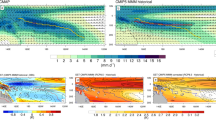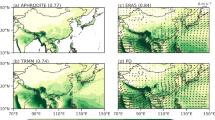Abstract
Theoretical and empirical studies have suggested that an underestimate of the ENSO asymmetry may be accompanied by a climatologically smaller and warmer western Pacific warm pool. In light of this suggestion, simulations of the tropical Pacific climate by 19 Coupled Model Intercomparison Project Phase 3 (CMIP3) climate models that do not use flux adjustment were evaluated. Our evaluation revealed systematic biases in both the mean state and ENSO statistics. The mean state in most of the models had a smaller and warmer warm pool. This common bias in the mean state was accompanied by a common bias in the simulated ENSO statistics: a significantly weak asymmetry between the two phases of ENSO. Moreover, despite the generally weak ENSO asymmetry simulated by all models, a positive correlation between the magnitude of the bias in the simulated warm-pool size and the magnitude of the bias in the simulated ENSO asymmetry was found. These findings support the suggested link between ENSO asymmetry and the tropical mean state-the climatological size and temperature of the warm pool in particular. Together with previous studies, these findings light up a path to improve the simulation of the tropical Pacific mean state by climate models: enhancing the asymmetry of ENSO in the climate models.
Similar content being viewed by others
References
AchutaRao, K., and K. R. Sperber, 2002: Simulation of the El Niño Southern Oscillation: Results from the coupled model intercomparison project. Climate Dyn., 19, 191–209.
An, S.-I., Y.-G. Ham, J.-S. Kug, F.-F. Jin, and I.-S. Kang, 2005: El Niño-La Niña asymmetry in the coupled model intercomparison project simulations. J. Climate, 18, 2617–2627.
Boville, B. A., and P. R. Gent, 1998: The NCAR climate system model, version one. J. Climate, 11, 1115–130.
Burgers, G., and D. B. Stephenson, 1999: The “normality” of El Niño. Geophys. Res. Lett., 26, 1027–1030.
Clement, A. C., R. Seager, M. A. Cane, and S. E. Zebiak, 1996: An ocean dynamical thermostat. J. Climate, 9(9), 2190–2196.
Clement, A. C., R. Seager, and R. Murtugudde, 2005: Why are there tropical warm pools? J. Climate, 18(24), 5294–5311.
Davey, M., and Coauthors, 2002: STOIC: A study of coupled model climatology and variability in tropical ocean regions. Climate Dyn., 18, 403–420.
Delworth, T., and Coauthors, 2006: GFDL’s CM2 global coupled climate models. Part I: Formulation and simulation characteristics. J. Climate, 19, 643–674.
Dijkstra, H. A., and J. D. Neelin, 1995: Oceanatmosphere interaction and the tropical climatology Part II: Why the Pacific cold tongue is in the east. J. Climate, 8, 1343–1359.
Furevik, T., M. Bentsen, H. Drange, I. K. T. Kindem, N. G. Kvamsto, and A. Sorteberg, 2003: Description and evaluation of the Bergen climate model: ARPEGE coupled with MICOM. Climate Dyn., 21, 27–51.
Goosse, H., and T. Fichefet, 1999: Importance of iceocean interactions for the global ocean circulation: A model study. J. Geophys. Res., 104, 23337–23355.
Gordon, C., C. Cooper, C. A. Senior, H. T. Banks, J. M. Gregory, T. C. Johns, J. F. B. Mitchell, and R. A. Wood, 2000: The simulation of SST, sea ice extents and ocean heat transports in a version of the Hadley Centre coupled model without flux adjustments. Climate Dyn., 16, 147–168.
Gordon, H. B., and Coauthors, 2002: The CSIRO Mk3 climate system model. aspendale: CSIRO atmospheric research. (CSIRO atmospheric research technical paper; no. 60). 130pp. [Available online at http://www.cawcr.gov.au/publications/technicalreports/CTR 021.pdf.]
Hannachi, A., D. B. Stephenson, and K. R. Sperber, 2003: Probability-based methods for quantifying nonlinearity in the ENSO. Climate Dyn.,. doi: 10.1007/s00382-002-0263-7.
Hansen, J., and Coauthors, 2008: Target atmospheric CO2: Where should humanity aim? The Open Atmospheric Science Journal, 2, 217–231, doi: 10.2174/1874282300802010217.
Held, I. M., and A. Y. Hou, 1980: Nonlinear axially symmetric circulations in a nearly inviscid atmosphere. J. Atmos. Sci., 37, 515–533.
Hou, A. Y., 1998: Hadley circulation as a modulator of the extratropical climate. J. Atmos. Sci., 55, 2437–2457.
Jin, F.-F., 1996: Tropical ocean interaction, Pacific cold tongue, and El Niño Southern Oscillation. Science, 274, 76–78.
Johns, T. C., and Coauthors, 2006: The new Hadley Centre climate model (HadGEM1): Evaluation of coupled simulations. J. Climate, 19, 1327–1353.
Kiehl, J. T., 1998: Simulation of the tropical Pacific warm-pool with the NCAR climate system model. J. Climate, 11, 1342–1355.
Kiehl, J. T., and P. R. Gent, 2004: The community climate system model, version 2. J. Climate, 17, 3666–3682.
Kug, J.-S., J. Choi, S.-I. An, F.-F. Jin, and A. T. Wittenberg, 2010: Warm pool and cold tongue El Niño events as simulated by the GFDL 2.1 coupled GCM. J. Climate, 23, 1226–1239.
Latif, M., and Coauthors, 2001: ENSIP: The El Niño simulation intercomparison project. Climate Dyn., 18, 255–276.
Leloup, J., M. Lengaigne, and J.-P. Boulanger, 2008: Twentieth century ENSO characteristics in the IPCC database. Climate Dyn., 30, 277–291.
Liang, J., X.-Q. Yang, and D.-Z. Sun, 2012: The effect of ENSO events on the tropical Pacific mean climate: Insights from an analytical model. J. Climate, 25, 7590–7606.
Lu, P., J. P. McCreary Jr., and B. A. Klinger, 1998: Meridional circulation cells and the source waters of the Pacific equatorial undercurrent. J. Phys. Oceanogr., 28, 62–84.
Mechoso, M. R., and Coauthors, 1995: The seasonal cycle over the tropical Pacific in coupled ocean-atmosphere general circulation models. Mon. Wea. Rev., 123, 2825–2838.
Meehl, G. A., C. Covey, T. Delworth, M. Latif, B. McAvaney, J. F. B. Mitchell, R. J. Stouffer, and K. E. Taylor, 2007: The WCRP CMIP3 multimodel dataset: A new era in climate change research. BAMS, 88, 1383–1394, doi: 10.1175/BAMS-88-9-1383.
Newell, R. E., 1979: Climate and the ocean. Amer. Sci., 67, 405–416.
Nozawa, T., T. Nagashima, H. Shiogama, and S. A. Crooks, 2005: Detecting natural influence on surface air temperatures change in the early twentieth century. Geophys. Res. Lett., 23, L20719, doi: 10.1029/2005GL023540.
Philander, S. G., 1990: El Niño, La Niña and the Southern Oscillation. Elsevier, New York, 293pp.
Pierrehumbert, R. T., 1995: Thermostats, radiator fins, and the runaway greenhouse. J. Atmos. Sci., 52, 1784–1806.
Ramananthan, V., and W. Collins, 1991: Thermodynamic regulation of ocean warming by cirrus clouds deduced from observations of the 1987 El Niño. Nature, 27–32.
Rayner, N., A., D. E. Parker, E. B. Horton, C. K. Folland, L. V. Alexander, D. P. Rowell, E. C. Kent, and A. Kaplan, 2003: Global analyses of sea surface temperature, sea ice, and night marine air temperature since the late nineteenth century. J. Geophys. Res., 108, 4407, doi: 10.1029/2002JD002670.
Rodgers, K. B., P. Friederichs, and M. Latif, 2004: Tropical Pacific decadal variability and its relation to decadal modulation of ENSO. J. Climate, 17, 3761–3774.
Russell, G. L., J. R. Miller, and D. Rind, 1995: A coupled atmosphere-ocean model for transient climate change studies. Atmos.-Ocean, 33(4), 683–730.
Salas-Mélia, and Coauthors, 2005: Description and validation of the CNRM-CM3 global coupled model, CNRM working note 103.
Schmidt, G., and Coauthors, 2006: Present-day atmospheric simulations using GISS ModelE: Comparison to in situ, satellite, and reanalysis data. J. Climate, 19, 153–192.
Schopf, P. S., and R. J. Burgman, 2006: A simple mechanism for ENSO residuals and asymmetry. J. Climate, 19, 3167–3179.
Spencer, R. W., 1993: Global oceanic precipitation from the MSU during 1979–91 and comparisons to other climatologies. J. Climate, 6, 1301–1326.
Sun, D.-Z., 2000: Global climate change and ENSO: A theoretical framework. El Niño: Historical and Paleoclimatic Aspects of the Southern Oscillation, Multiscale variability and Global and Regional Impacts. H. F. Diaz and V. Markgraf, Eds., 476pp, Cambridge University Press, Cambridge, 443–463.
Sun, D.-Z., 2003: A possible effect of an increase in the warm-pool SST on the magnitude of El Niño warming. J. Climate, 16, 185–205.
Sun, D.-Z., 2007: The role of ENSO in regulating its background state. Nonlinear Dynamics in Geosciences, J. Elsner and A. Tsonis, Eds., Springer New York, 537–555.
Sun, D.-Z., 2010: The diabatic and nonlinear aspects of El Niño-Southern Oscillation: Implications for its past and future behavior. Climate Dynamics: Why Does Climate Vary? AGU Geophysical Monograph, D.-Z. Sun and F. Bryan, Eds., Amer. Geophys. Union, 79–104.
Sun, D.-Z., and Z. Liu, 1996: Dynamic ocean-atmosphere coupling: A thermostat for the tropics. Science, 272, 1148–1150.
Sun, D.-Z., and K. E. Trenberth, 1998: Coordinated heat removal from the equatorial Pacific during the 1986–87 El Niño. Geophys. Res. Lett., 25, 2659–2662.
Sun, D.-Z., and T. Zhang, 2006: A regulatory effect of ENSO of ENSO on the time-mean thermal stratification of the equatorial upper ocean. Geophys. Res. Lett., 33, L07710, doi: 10.1029/2005GL025296.
Sun, F. P., and J.-Y. Yu, 2009: A 10-15-yr modulation cycle of ENSO intensity. J. Climate, 22, 1718–1735.
Trenberth, K. E., and A. Solomon, 1994: The global heat balance: Heat transports in the atmosphere and ocean. Climate Dyn., 10, 107–134.
Webster, P. J., and R. Lukas, 1992: TOGA COARE: The coupled ocean-atmosphere response experiment. Bull. Amer. Meteor. Soc., 73, 1377–1417.
Yu, Y., X. Zhang, and Y. Guo, 2004: Global coupled ocean-atmosphere general circulation models in LASG/IAP. Adv. Atmos. Sci., 21, 444–455.
Zhang, T., D.-Z. Sun, R. Neale, and P. Rasch, 2009: An evaluation of ENSO asymmetry in the community climate system Models: A view from the csubsurface. J. Climate, 22, 5933–5961, doi: 10.1175/2009JCLI2933.1.
Author information
Authors and Affiliations
Corresponding author
Rights and permissions
About this article
Cite this article
Sun, Y., Sun, DZ., Wu, L. et al. Western pacific warm pool and ENSO asymmetry in CMIP3 models. Adv. Atmos. Sci. 30, 940–953 (2013). https://doi.org/10.1007/s00376-012-2161-1
Received:
Revised:
Published:
Issue Date:
DOI: https://doi.org/10.1007/s00376-012-2161-1




